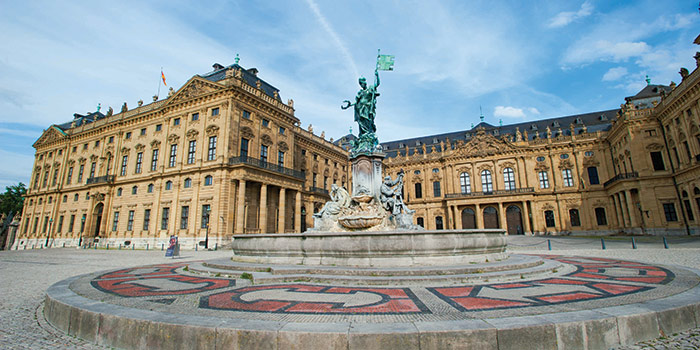
Wurzburg: Friday August 19

ORIGINAL PLAN
This morning, you may choose to join an optional full-day excursion along Germany’s picturesque “Romantic Road” to Rothenburg, with its turreted city wall and impressive Gothic and baroque architecture. Upon returning to Würzburg, enjoy a tour of the Bishops’ Residenz, one of Germany’s largest and most ornate baroque palaces and a UNESCO World Heritage Site. Rejoin your ship for dinner. (Breakfast, Lunch, Dinner)
Tour Würzburg’s Bishops’ Residenz, one of Germany’s largest and most ornate palaces and a UNESCO World Heritage Site. Drive with your guide to the former residence of the Würzburg prince-bishop that was built over a 25-year period, beginning in 1719. Admire the overhead ceiling with its stunning, 6,400-square-foot “Four Continents” fresco painted by Venetian artist Giovanni Tiepolo. You will see several of the building’s ornate rooms, the colonnaded chapel and the baroque and English-style gardens lined with ornate statues. A highlight is sure to be the Mirror Cabinet. Incredibly, the entire complex was meticulously reconstructed after suffering extensive damage from World War II bombing. Afterward, continue to the Old Town of Würzburg, where a walking tour shows you the stunning Romanesque Cathedral, the Neumünster church, the market square and Town Hall, and the oldest wine bar in town.
* Easy - Walking portions are generally over easy surfaces with few steps or inclines. Total time walking or standing is normally not longer than 1.5 hours.
1:45 – 4:45 pm: Wurzburg Residenz & Walk (Viking included) Jim & Barbara reserved
OUR EXPERIENCE
An overview for the day with special insights was in the Viking Daily.
As our ship pulled into Wurzburg, we could see the Marienberg Fortress, a symbol of Würzburg which served as a home of the local prince-bishops for nearly five centuries. It has been a fort since ancient times.
By the time we had docked, we had decided, along with Bill, Lana, Bev, and Judy, to skip the tour because of the long walk. Instead, Barbara and I planned our own tour while the others went shopping in the town center. Barbara spotted St. John Bosco Church across the river northwest of the bridge, Alte Mainbrucke. We took pictures of most anything that mentioned Don Bosco or Salesians:
The church door was locked so we asked for directions to the Salesian residence. When we found the front door, I rang all the buzzers, knocked on the door and waited. When no one answered we walked away:
Then we heard someone shouting. It turned out to be the Director, Fr. Hatto Von Hatzfeld (ordained in 1992). He let us into the church where we took more pictures as he told us the history:
The church dated back to 1134 and was called St James Church. Even now it is on the pilgrim's route to Santiago de Compostela complete with a stamp for the pilgrims. Missionaries from Ireland and Scotland had established the church there. Scots still live in the area. We took a few more pictures inside the church, said thanks and goodbye, then headed back to the bridge:
Barbara remembered a guide telling us about a restaurant on top of a department store with a great view overlooking the bridge including the twin steeples of St. John Bosco Church:
Tourists grabbed glasses of wine and wandered across the bridge. We joined the wine tradition by ordering two wines selections from a menu. They turned out to be the same except that one had sparkling water added. We sipped half a glass then traded glasses while fighting off some stray bees scouting for morsels on our table. From there we went down a flight of stairs to the toilette then toured the store. I was looking for men's underwear to see if I paid too much to have some briefs laundered on the Viking ship. The ship charged 4 euros a pair. I figured I could buy them for less. Wrong. They were 30 euros for 3 pairs. We found our expensive box of finished laundry on our bed when we returned to our cabin later:
Once that was resolved, we descended the escalator to the ground floor and walked toward the town center across the bridge:
We searched for a refrigerator magnet commemorating our time in Wurzburg. Six euros later, we found a good one then sought a place to sit down by a nearby dry fountain. Barbara clicked a picture of a boy playing with some bronze statues. One was the serpent, Satan; the other a naked Eve biting the apple.
Soon we had to return to the Viking ship. We recognized fellow passengers by the earphones and listening devices issued to those on tour, so we followed the group to be close to the leader. He didn't recognize us and asked if we belonged. I showed him our tickets to the excursion that we had skipped which happened to be his group. Now we could follow him and hear his narration. We tipped him as the tour ended. Coincidentally, we ran into Lana, Judy, Bev, and Bill returning from their shopping and decided to sit on a bench for a short rest:
By 5:00 we were back on board the ship resting before dinner. Resting for me was writing the journal of another adventure that I hope to share with everyone, especially my Salesian friends. Later, I did research showing that the Smithhisler clan on Barbara's side had come from Dettwiller France about 3 hours by car southwest of Wurzburg. They came from Alsace, France, but Philip Smitthisler was a German citizen and renounced any allegiance to the King of France.